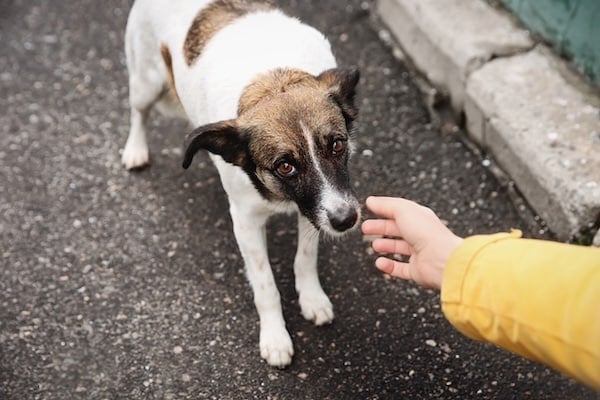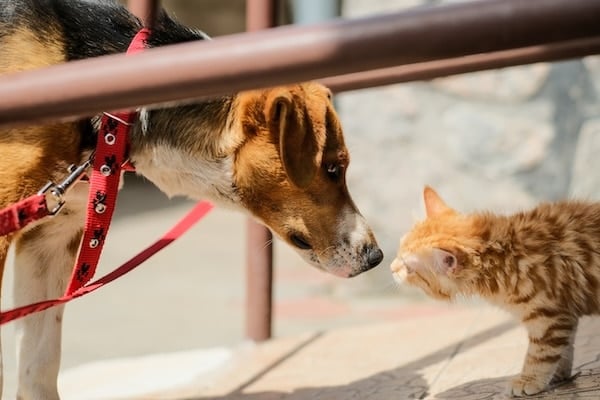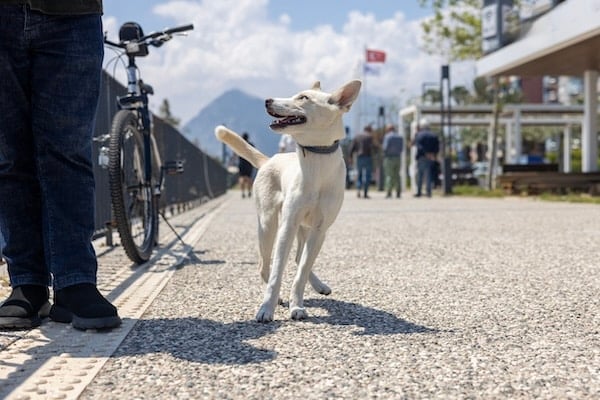- This article has been reviewed by a pet health professional. It is not a substitute for professional veterinary advice.
You’re walking your dog through the neighborhood when suddenly they lunge, bark, or growl at a passing dog, person, or car. It’s not the first time, and unfortunately it’s most likely not going away. If this sounds familiar, you’re in good company: according to a recent survey by Rover, nearly two-thirds of dog parents say their dog currently experiences some form of reactivity, whether that’s toward people, animals, or handling.
“Reactivity” can be a loaded word. It’s often confused with “aggression,” but according to Kait Hembree, head of training at GoodPup, these aren’t the same thing. “Reactivity is just an overreaction towards a trigger—and generally an unwanted overreaction,” she adds. And if your dog has severe reactivity or a lot of triggers, it can make outings hard on both of you.
In this article, we’ll walk you through what reactivity looks like, why it happens, common triggers, and how to manage and train a reactive dog using positive, science-backed methods.
Signs of Reactivity in Dogs
Reactivity doesn’t just happen on the leash—it can show up in your home, yard, or anywhere your dog feels overwhelmed. Depending on the nature of your dog’s trigger, you might see behaviors like:
- Hypervigilance (scanning the environment, quick head turns)
- Raised hackles (piloerection)
- Sudden stillness or full-body tension
- Wide eyes with dilated pupils
- Forward or pinned-back ears
- Cowering, hiding, or trying to flee
- Lip curling or baring teeth
- Tail tucked or stiff
- High-pitched barking or growling
- Lunging, jumping, especially when leashed
Vocalizations and tail movements can vary from dog to dog, so always consider the full context of your dog’s behavior when observing for reactivity.
What Causes Reactivity?
Reactivity is both psychological and physiological. A dog’s overreaction is a manifestation of the emotion they are feeling. Emotions like fear, worry, excitement, overstimulation, or frustration triggered from stress result in an internal response for your dog, including increased heart rate and a surge of cortisol. And there’s often an underlying cause.
Trauma
Dogs who’ve experienced trauma, whether a single scary event or repeated stressful exposures, may become reactive—especially if their earlier, subtler distress signals didn’t work.
“They have had to resort to extreme behaviors as the early ‘asking politely’ signs were ignored,” says Jo Sellers, accredited dog trainer and founder of Pippin Pets Dog Training.
While we might assume rescue dogs are more prone to reactivity, that’s not always the case. Any dog can display reactive behavior. Still, many rescues have faced tough conditions that can increase the likelihood of reactivity being brought to the surface.
Incomplete or insufficient socialization
Puppies go through a critical window of social development, and if they don’t safely experience a wide range of people, places, and other animals, they may struggle to feel safe and confident later as an adult.
Even one bad interaction, like rough play from another dog, can create a lasting fear where barking or growling may become your dog’s go-to defense mechanism.
Genetics
Anxiety-inducing hormones can be passed genetically from mom dogs to their pups, Sellers says.
While any dog can be reactive, some breeds are at greater risk than others. For example, herding breeds, with their alertness and sensitivity to movement, may be more likely to struggle with reactivity towards moving cars, bikes, and prey animals.
Handling and past experiences
How a dog is handled by humans or other dogs can strongly influence their behavior. Heavy handling, intimidation, and fearful methods—including aversive equipment—can all create painful associations, says Sellers, influencing the likelihood of them being reactive over time. Even well-meaning touch can feel overwhelming to some dogs.

Liudmila Chernetska via iStock
Types of Reactivity & Common Triggers
Understanding what triggers your dog’s reactivity is the first step in helping them feel safe and stay calm. A dog can be reactive to just about any stimulus, but some are more common than others.
Leash reactivity
If you have a leash reactive dog, they probably tend to overreact while restrained, usually barking, lunging, or whining at other dogs, people, or objects while walking on a leash. This often stems from frustration at not being able to move freely or fear of an approaching trigger. Because they’re on a leash, they can’t choose to escape or to approach as they feel comfortable. This often defaults to fight-or-freeze responses.
Leash reactivity is one of the most common forms of reactivity and may appear even in dogs who seem relaxed when off-leash.
Dog reactivity
Some dogs react specifically to the sight, smell, or sound of other dogs. This can show up as barking, growling, or attempts to charge at the other dogs, even if they’re generally social in other settings.
Sometimes this is due to a lack of socialization or a negative past experience with another dog. In other cases, a dog may simply feel overwhelmed or uncertain of other dogs. It’s important to recognize that even friendly dogs can display reactive behaviors toward other dogs in overstimulating environments.
People reactivity
A dog who is reactive to people may bark, growl, or hide when unfamiliar people approach. They can even react to specific triggers, including people wearing hats, children running, or people with novel movements. This can be due to fearfulness or a lack of exposure, especially during a puppy’s critical development period.
While some dogs are reactive to certain triggers, others may react to types of people, like men, people of different statures, or just people entering their space, such as new visitors entering their home.
Cat reactivity
Dogs who are reactive to cats may fixate, chase, bark, or whine when they see or smell one. For some, this is rooted in prey drive, while others may simply be overstimulated by feline movement and behavior or be unfamiliar in general with the species.
Reactivity to cats can be especially challenging in multi-pet households or shared outdoor spaces. With management and training, it’s often possible to reduce reactivity and teach dogs to remain calm around specific cats they are exposed to.

Aleksandr Vitko via iStock
How To Manage Reactivity
There are two parts to dealing with reactivity: management, which prevents the continued rehearsal of the behavior, and training, which focuses on teaching dogs a more appropriate way to respond.
Managing reactivity means taking steps to reduce the chances of a reactive episode before it starts. This often involves avoiding triggers, planning ahead, and staying calm and supportive when reactivity does occur. Think of it as helping your dog keep their stress level in check while you build long-term skills through training.
Below are some practical ways to manage reactivity in the moment and day to day.
Avoiding triggers
One of the most effective ways to manage reactivity is to prevent it altogether by steering clear of known triggers. If your dog reacts to other dogs, avoid busy walking times or skip the dog park entirely. Cross the street when another dog approaches. Give your pup space in parking lots, hallways, or crowded trails. This will set your dog up to feel safe and successfully deter their reactivity.
Some trainers even recommend pausing walks for a while and focusing instead on indoor activities. If leash reactivity is a daily stressor, try playing scent games, using food puzzles, or practicing tricks at home. These activities can meet both physical and mental needs without pushing your dog past their comfort zone.
Calming when triggered
Even with your best efforts, reactive moments will happen.
“You need to have a backup plan that is specific to your environment and your dog,” says Hembree. This could be crossing behind a car, ducking behind trash cans, teaching your dog to get behind you, or tossing treats in the opposite direction of the trigger. The goal is to create space from the trigger, allowing your dog to deescalate as quickly as possible.
When building a plan, try to avoid including any punishment techniques, like yanking on the leash or tightly restraining your dog. Often these tactics will only make their stress worse. Instead, focus on creating distance and helping them recover calmly. A few deep breaths and a quiet retreat can make a big difference for both of you.
How to handle boarding and care
If your dog needs to stay with a pet sitter or boarding facility, be proactive. Let caregivers know about your dog’s triggers, and be honest about what to expect. Providing a clear routine, safe spaces, and familiar items like a favorite blanket or toy can help ease stress.
How To Train a Reactive Dog
Training a reactive dog takes time, patience, and a good understanding of what’s driving their behavior. With training, you can reduce how often it shows up and how intense it becomes for your dog. The goal of training is to change your dog’s emotional response through calm, systematic and controlled exposure while rewarding them for a more appropriate, alternative behavior.
Plus, studies show that by using training to keep behavioral problems from worsening, you can help strengthen the bond between you and your dog.
Identifying triggers
If you’re not sure what your dog’s triggers are, careful exposure to a checklist of new things is a good first step. Your goal will be to slowly introduce your dog to new situations, people, or animals through a gradual process that doesn’t overwhelm them.
Start at a distance where your dog can notice a trigger (like a person or another dog) without reacting. Praise them and offer treats while they stay calm. Gradually decrease the distance over time, based on your dog’s comfort level.
If your dog shows signs of stress, move away from the trigger and make a note that this is an area to work on.
If your dog stays calm even as the stimulus gets closer, louder, or more intense, call it a win and cross it off your list.
Desensitization and counterconditioning
Once you’ve identified your dog’s triggers, training in conjunction with desensitization and counterconditioning can help change how they feel and react.
Desensitization means exposing your dog to their trigger—like the sight of another dog from far away. It’s a gradual process of slowly increasing the intensity of the trigger, decreasing the distance to the other dog.
At the same time, you will be rewarding your dog for performing a more appropriate, alternative behavior. During this practice, counterconditioning is happening. The exposure to the trigger is being paired with something positive, like a treat reward for the behavior.
Let’s say your dog lunges when they see a bicycle. At first, you might start far away from the bike where your dog is relaxed, feeding them treats for sitting calmly. Then slowly over time, you’ll decrease that distance until your dog can sit politely while taking treats as a cyclist goes by them.

Tamer ALKIS via iStock
Where To Get Help
You don’t have to navigate reactive dog training on your own. Whether you’re feeling overwhelmed, frustrated, or just unsure of your next step, there’s support available to help both you and your dog feel more confident and connected.
When to see a trainer
“It’s never too soon to get a second opinion,” says Hembree. Even early on, a trainer can reassure you, help you make sense of what you’re seeing, and help you build a plan.
If your dog’s body language or reactions are making you feel uncomfortable, Hembree says that’s a clear sign it may be time to bring in professional support. Look for a humane, reward-based certified dog trainer or behavior consultant emphasizing positive reinforcement. You want a trainer who focuses on building trust and teaching skills.
Most importantly, they’ll help you and your dog return to a manageable “baseline,” opening the door for teaching new skills that support calmer behavior and improve your relationship for the long run.
When to see a vet
Reactivity isn’t always just behavioral. There could be an underlying medical condition that is causing your dog pain, which can trigger reactive-type responses. If your dog’s reactions seem extreme or have changed suddenly, it’s a good idea to schedule a vet check.
Your vet may also recommend medication to help manage stress or anxiety. When used in conjunction with training, medication can be especially helpful for dogs who have a hard time calming down or staying at baseline.
How Long Does It Take for Reactivity To Get Better?
It’s important to remember that reactivity causes your dog’s body to release hormones like cortisol and adrenaline when they’re overwhelmed. Hembree says these stress hormones can take up to 72 hours to leave your dog’s system. So if your dog has a tough outing on Monday, they might still be feeling the effects on Wednesday or even Thursday.
Before training can be effective, your dog needs to be back at baseline, meaning their stress levels are low enough to learn. For some dogs, that might take a couple of days. For others, it could take a week or more, especially if they’re more frequently exposed to triggers. That’s why managing their environment is such an important first step.
Once your dog is at baseline, you can begin skill-building and carefully reintroduce triggers through training. Over time, you may notice your dog becoming more resilient, recovering from stress more quickly, or reacting less intensely. Progress may be slow at first, but even small wins add up!
Remember, reactivity isn’t a life sentence. With time, support, and consistent training, your dog can feel safer and more at ease, and so can you.



